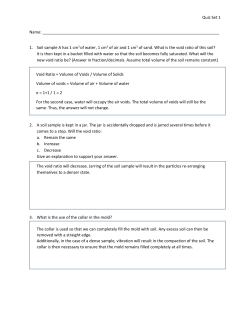
Soil Sample Information Sheet for Home Lawns, Gardens, Fruits, and Ornamentals
Virginia Tech Soil Testing Laboratory Publication 452-125 Revised 2013 Soil Sample Information Sheet for Home Lawns, Gardens, Fruits, and Ornamentals Please Print (Form expires January 2015) INSTRUCTIONS: See other side for sampling instructions. For a recommendation, be sure to fill in the plant code number. Place check marks ( √ ) where appropriate. Use another form for commercial crop production. Send samples, forms, and payment to Virginia Tech Soil Testing Lab, 145 Smyth Hall (MC 0465), 185 Ag Quad Ln, Blacksburg VA 24061, in a sturdy shipping carton weighing less than 37 pounds. Processing will be delayed if soil is not received in an official sample box. See www.soiltest.vt.edu for more information. Your Name: ____________________________________________________________________________ Date sampled: E-mail: _______________________________________________ ____________ MM/DD/YY Phone: ________________________ Mailing Address: ________________________________________________________________________ _______________________________________________________________________________________ City: _______________________________________ Office Use only Extension Unit Code: ZIP Code (required): _______________________ County Where Soil is Located (required): __________________________________________________ Copy Report To (Consultant, etc.): __________________________________________________________ Their E-mail: ___________________________________________________________________________ SAMPLE IDENTIFICATION Your Sample Box Number or Name (Up to 5 digits) PLANT TO BE GROWN Insert Plant Code # from list at right SOIL INFORMATION Last Lime Application Months Previous – 0–6 7 – 12 13 – 18 19+ Pounds per 1,000 sq. ft. 0 10 – 50 51 – 100 101 – 150 151+ PLANT CODE LIST Lawn: Kentucky Bluegrass, Non-Acid-Loving Shrubs Fescue, or Ryegrass and Trees 201Establishing New Lawn 202Maintaining Lawn, Repair of Bare Spots 245Shrubs - Lilac, Forsythia, Boxwood, etc. 246Trees - Pine, Maple, Oak, etc. Fruits Lawn: Bermudagrass, Zoysiagrass, or St. Agustine 220Apples 203 Establishing New Lawn 204Maintaining Lawn, Repair of Bare Spots Garden 210Vegetable Garden 211 Flower Garden 212Roses Acid-Loving Shrubs 240Azaleas 241Andromedas 242Camellias 243Laurel 244Rhododendron SOIL TESTS DESIRED AND FEES 221Blackberries 222Blueberries 223Currants 224Gooseberries 225Grapes 226Nectarines 227Peaches 228Pears 229Plums 230Quince 231Raspberries 232Sour Cherry 233Strawberries 234Sweet Cherries House Plants 250Potted House Plants COST PER SAMPLE IN-STATE OUT-OF-STATE Routine (soil pH, P, K, Ca, Mg, Zn, Mn, Cu, Fe, B, and estimated CEC) $10.00 $16.00 Organic Matter – Determines percentage in soil – no recommendation given $4.00 $6.00 Soluble Salts – Determines if fertilizer salts are too high $2.00 $3.00 Send in payment along with soil sample and form; make check or money order payable to “Treasurer, Virginia Tech.” Important: For test results to be meaningful, use extreme care when taking soil samples. Each sample represents many tons of soil in your lawn or garden. Test results cannot be any more accurate than the sample submitted to the laboratory. Do not take samples when the soil is extremely wet. Sampling Instructions: Divide your lawn or garden into sampling areas. Each area should be uniform in the kind of soil and in the past fertilizer and lime treatments it has received. An example would be separate samples (areas) for front and back lawns. For shrubs and trees, select an area from the trunk to the outer edges of the branches. Take a separate sample from each area as shown in the diagram below. Use the following procedure for each sampling area: A – Take samples with a trowel, shovel, spade, or auger. Make a vertical cut 4" deep for lawns, or to plowing depth for gardens, and push the soil aside. Then cut a thin slice from the side of the opening that is of uniform thickness, approximately 2" in width, and extending from the top of the ground to the depth of the cut. Scrape away or discard any surface mat of grass or litter and place the slice of soil into a clean bucket or other container. Follow this sampling procedure in 10 or more different locations within each sampling area, each time placing the resulting soil in the same container, giving you a composite sample. B – Thoroughly mix the soil from the composite sample and then fill the sample box to the top with the mixture. Fill in the information requested on the side of the sample box, including sample number, complete the other side of this sheet, and send sample, sheet, and payment directly to the Soil Testing Laboratory. For additional sampling instructions go to www.soiltest.vt.edu. Reviewed by Steve Heckendorn, laboratory manager, Crop and Soil Environmental Sciences www.ext.vt.edu Produced by Communications and Marketing, College of Agriculture and Life Sciences, Virginia Polytechnic Institute and State University, 2013 Virginia Cooperative Extension programs and employment are open to all, regardless of race, color, national origin, sex, religion, age, disability, political beliefs, sexual orientation, genetic information, marital, family, or veteran status, or any other basis protected by law. An equal opportunity/affirmative action employer. Issued in furtherance of Cooperative Extension work, Virginia Polytechnic Institute and State University, Virginia State University, and the U.S. Department of Agriculture cooperating. Edwin J. Jones, Director, Virginia Cooperative Extension, Virginia Tech, Blacksburg; Jewel E. Hairston, Administrator, 1890 Extension Program, Virginia State, Petersburg. VT/0913/CSES-66NP
© Copyright 2025





















